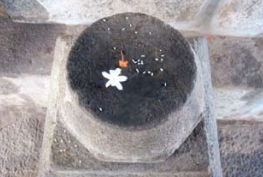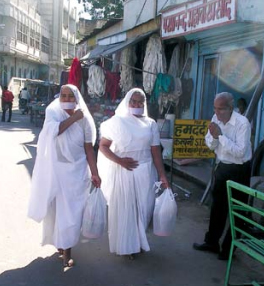
Centre of Jaina Studies Newsletter: SOAS - University of London
My doctoral dissertation examines representations of nuns in Indian Buddhist and Śvetāmbara Jain monastic commentaries from the sixth and seventh centuries CE. Although these texts comment extensively on the nuns' rules in the two traditions, they have been hitherto virtually overlooked by scholars investigating the history of Buddhist and Jain nuns. In an effort to bring to light some of this rich material, this work analyzes the discussions on women's monastic practice and virtue in the commentaries of two roughly contemporaneous monastic scholars: the early seventh-century CE Mūlasarvāstivādin Buddhist scholar Guṇaprabha and the late sixth-century CE Śvetāmbara Jain exegete Saṅghadāsa. On the Buddhist side, I focus on Guṇaprabha's Vinayasūtra and its autocommentary, the Vinayasūtravṛtty-abhidhānasvavyākhyānam (Tib. 'Dul ba'i mdo'i 'grel pa mngon par brjod pa rang gi rnam par bshad pa). The Jain commentaries I examine are the Bṛhatkalpabhāṣya and Vyavahārabhāṣya attributed to Saṅghadāsa. These two belong to the bhāṣya (bhāsa) layer of Jain exegetical literature, written in Māhārāṣṭrī Prakrit verse and dated to the period between 500-700 CE. These encyclopedic texts offer detailed explanations of Śvetāmbara Jain mendicant discipline as laid out in the root texts, the canonical Chedasūtras.
Although the order of Jain female mendicants is arguably the oldest monastic tradition for women in the world, only a few studies have thus far examined the history of this tradition. S. B. Deo devoted a chapter to the Jain order of nuns in his monumental History of Jaina Monachism in 1956. Shāntā's 1985 study, while focused on contemporary communities, includes a survey of inscriptional and textual references to Jain nuns. Some scholarship is accessible only in Hindifor example, the recent two-volume historical study of Jain nuns by Dr. Śramaṇī Vijayaśrī.1 Studies that specifically adopt gender as an analytical lens, or provide robust analyses of textual representations of Jain nuns, have been virtually non-existent
It is this gap in Jain Studiesand, arguably, in the historical study of South Asian religions at largethat this dissertation seeks to fill. In choosing gender as an analytical category, my intent is not simply to identify renunciant women as a distinct object of study, but rather to examine how gender operates in Jain texts to produce particular kinds of portrayals of, and claims about, monastic men and women. In doing so, I hope to model responsible ways of reading male-authored sources on women. A second contribution to Jain Studies is the focus on Chedasūtra commentaries, a rich but still deplorably understudied body of texts. I pay close attention to the ways in which Saṅghadāsa utilizes Jain commentarial techniques and rhetorical tools to make specific kinds of arguments about monastic women. Thirdly, this study argues for the necessity of situating Jain discourses on nuns within the larger historical context of South Asian traditions of renunciant women and attitudes towards them. Even though the Buddhist and Jain orders of nuns developed side-by-side and had to negotiate similar issues, there have been virtually no sustained comparative analyses of Buddhist and Jain discourses on nuns. Carrying out such an analysis, and placing it in the context of other texts from the same period enables us to discern the kinds of cultural currents and concerns that motivated the Buddhist and Jain authors' statements about women in their communities.

I suggest that, in defining the way of life of a nun, both Guṇaprabha and Saṅghadāsa were participating in wider conversations regarding the roles and practices appropriate for women, and the importance of demonstrable female virtue for the prestige of a community. Other texts from around this period indicate that female renunciation was a contested issue across religious boundaries in early medieval South Asia. In order to understand this wider intertextual context, the dissertation begins with a study of attitudes to female renunciation in a range of sources from around the middle of the first millennium CE: the Brahminical Dharmaśāstras, other kinds of technical treatises (śāstra) composed in Sanskrit, and courtly literature. All of these sources problematize women's renunciatory practice and cast renunciant women as suspect, albeit in different ways. The Dharmaśāstras, for example, categorically deny women's eligibility for formal renunciation (saṃnyāsa). Courtly literature, as well as treatises such as the Kāma-sūtra and the Arthaśāstra, consistently portray female ascetics as morally questionable, associated with the realms of sexuality and political intrigue.
Through a close analysis of the Buddhist and Jain monastic commentaries' sections on nuns, this dissertation argues that their authors were aware of, and responding to, these contestations, particularly to the negative associations of renunciant women with immorality. Such perceptions presented a problem for male monastic authorities, for they had implications on the reputation and prestige of the monastic communities at large and, one might argue, on the public image, and self-image, of a celibate male monastic who is associated with a group of nuns. The commentators' prescriptions for nuns seek to ible distinction between them and the stereotypical loose and worldly renunciant woman. They prescribe practices and gestures that mark the nuns in their communities as modest and disciplined, while deflecting charges of immorality onto female renunciants of other groups. On the other hand, the commentators must also demonstrate that their nuns are not independent or uncontrolled, but supervised and guarded by monks. The resulting, mutually contradictory portrayals of the nuns in these textsas superior in virtue to the female members of other communities, yet weak, incapable, and morally corruptible in comparison with monksreflect the contradictory position in which the monks find themselves, as celibate men institutionally in charge of women.
Chapter Two examines the conceptions of gender that seem to inform Saṅghadāsa and Guṇaprabha's presentation of the distinct rules for male and female monastics. This analysis shows that the two commentators in fact share many of the assumptions that find expression in the Brahminical treatises regarding women's nature and the necessity of male guardianship and supervision for women's virtue.
The third chapter focuses on the relationships between the male and female orders in the two traditions. I argue that evocations of the nuns as weak, and portrayals of the monks as strong and determined, celibate heroes, are a part of the rhetoric with which monastic commentators try to explain their position to themselves and to their audiences.
The focus of Chapter Four, "The Making of a Virtuous Nun," are the practices that presumably cultivate ideal kinds of habits, bodily demeanors, and dispositions in the nuns who undertake them. In this chapter, I demonstrate that most discussions of the nuns' rules gravitate towards one central concern, namely, guarding the nuns' celibacy. In general, there are striking similarities between the prescriptions of the Buddhist and Jain commentatorseven in their details.
In the fifth and final chapter, I turn to questions that I have deliberately suspended in the rest of the dissertation in order to examine the commentators' rhetoric on its own termsnamely, questions regarding their actual historical contexts and the historical monastic women who were a part of those contexts. I consider possible reading strategies for shedding light on contemporaneous conversations and controversies that left their imprint on the commentaries. In particular, we detect in the texts indications of nuns' potential access to different kinds of authority, charisma, and powerascetic, social, economic, and magical.
In short, this dissertation proposes to fill the need for a sustained study of specific texts that is at once philologically grounded, engaged in recent developments in historiography and gender theory, and looking across religious traditions.

Terāpanth nuns on their almsround in Mumbai
Mari Jyväsjärvi received her PhD from Harvard University in 2011. She is currently a Visiting Assistant Professor at Reed College, where she teaches South Asian religions. Her research focuses on South Asian ascetic and monastic traditions, particularly on the history of women's participation in these traditions.
 Mari Johanna Jyväsjärvi
Mari Johanna Jyväsjärvi